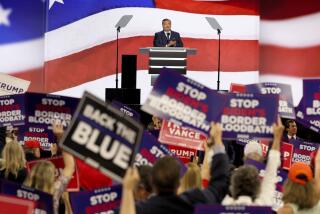Public Perception of Soaring Crime Skewed, Experts Say : Safety: Polls show that a majority of Americans fear becoming victims, but statistics indicate their fears are often unfounded. Media, politicians blamed.
Wanted: the true crime rate. If ever a mystery persisted in the annals of American crime, it’s the magnitude of crime itself.
Anxiety about crime grips the land but, looking at federal statistics, you have to wonder why. The FBI reports crime is merely crawling upward. Victim surveys show crime actually falling.
But for many people, an evening stroll, an unlocked car or going alone to the mall hint at lunacy. After tucking in their children, many parents bolt the doors, check the alarms and pat the guns under their beds good night.
Measuring the dimensions of crime in the United States is a statistical nightmare: This is a vast, populous country in which crime rates vary sharply, even from police precinct to neighboring police precinct. Try to draw a picture of crime besetting 250 million people and you lose the detail.
Polls indicate people feel more vulnerable, to violent crime especially. This fear fuels the “three strikes, you’re out” efforts occupying Congress and close to 30 states this year, the avid prison building and the pervasive unease.
Are perceptions wildly out of sync with statistics?
First, some numbers:
* Crime reported by police the last 20 years climbed 36%, FBI Uniform Crime Reports figures show. The overwhelming majority of reported crime--85%--was property crime. But the largest jump in any category came in the area of violent crime, which shot up 81%, driven mainly by juveniles with guns settling drug scores.
* The two-decade federal victims survey indicated a 29% drop in crime nationwide since 1975. The National Crime Victimization Survey counts one in four households visited by crime each year, down from about one in three in 1975. The survey also found the rate of violent crime basically unchanged, except for a sharp increase in teen-age and black victims.
* Last year, about 24,500 murders were reported in the United States. That’s much as it has been for the last several decades.
“The best scientific evidence we have clearly shows there is no increase in crime or violent crime in the last 20 years,” said William Chambliss, a sociologist at George Washington University.
“The fact is, even if the crime rate was going up, the victims who were the victims remain the victims,” said Chambliss, who also is a past president of the American Society of Criminology. “The most dangerous place you can go is to your home with your boyfriend or girlfriend, family members and acquaintances. They account for most of the violent crimes that take place.”
Forget the statistics, you might say. Everyone knows crime is America’s biggest worry nowadays.
National polls show not only that, but that many people think it is increasing in their own communities--and even more think it is increasing nationally.
An Associated Press poll of 1,004 Americans, taken in April, found 52% of men and 68% of women personally worried about becoming crime victims. Even among those who said there was nowhere within a mile of their homes they would be afraid to walk at night, half still worried about being victimized.
One reason crime gets the spotlight is that it’s moved up on the charts, ahead of foreign crises and the economy.
Crime always ranks high on polls evaluating the country’s most important problems, said Tom W. Smith, director of the General Social Survey at the National Opinion Research Center, based at the University of Chicago.
And with the Cold War over and the economy brightening, politicians took note of Americans’ intensified outrage against crime, adding their own spin.
“For good political reasons, the Congress and the President have found crime is something politically attractive to be against,” Smith said.
Other influences are at work. Crime stories permeate American life--witness their popularity as a topic of news and entertainment.
Last year, crime news reported on the three major television networks more than doubled, and coverage of murders tripled, compared with 1992, according to a survey by the Center for Media and Public Affairs in Washington.
Another recent survey indicates this coverage rings familiar alarm bells. In a Times Mirror Poll released April 6, 63% of respondents said the media accurately depicts the amount of crime in this country, while 29% said it exaggerates. Half the people surveyed also said they were very concerned about becoming a crime victim, up from 36% in 1988.
Some criminologists suggest another reason the fear of crime might be greater than statistics warrant is the extra attention paid to crimes occurring in unusual spots.
But exceptional bloodshed doesn’t even ripple the crime graph line, even though it shocks.
“You only hear about a very small number (of crimes), and that is the impression that everybody carries around,” said Malcolm Young, who runs the Sentencing Project in Washington. “We’ve accepted the 19,000 (other killings) or whatever threshold we don’t hear about.”
More to Read
Sign up for Essential California
The most important California stories and recommendations in your inbox every morning.
You may occasionally receive promotional content from the Los Angeles Times.










